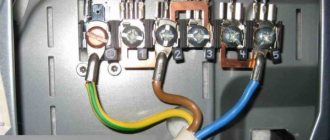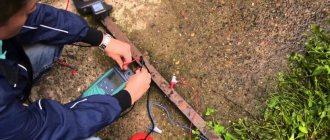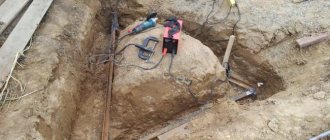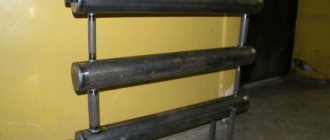- home
- Useful
- Vertical grounding: its characteristics and installation
»
»
The grounding conductor is an important component of the lightning protection system along with the lightning rod and lightning rod. By grounding, the incoming current is discharged into the ground, and thus about 50% of the charge is neutralized. Grounding electrodes come in different types and shapes, but they are all conventionally divided into vertical and horizontal - according to their location relative to the ground. In central Russia, it is vertical grounding that has become most widespread, since it is quite effective, although in some cases it is relatively difficult to install.
What is vertical grounding?
A typical vertical ground electrode is a metal pin that has a certain diameter and length necessary for reliable fixation in the ground. Metal is a good conductor of electricity, and due to financial feasibility, iron ground electrodes are most widely used (although copper wire can be used along with them).
Vertical grounding is carried out directly next to the construction site. Round or other shaped rods are used as grounding conductors. Since one metal pin may not be enough to discharge a large charge into the ground, several vertical ground electrodes are installed simultaneously. At the same time, they are connected to each other by fittings and electric welding.
Pipe stands
To install an entry device in a commercial building or country house, you must use a pipe stand.
Its main task is to fix the power wire that leads to the shield, as well as install the shield itself. According to the requirements of the PUE rules, the pipe stand requires mandatory grounding.
Not far from the shield, you need to drill a hole through which it is important to place a grounding bolt. Both the pipe stand itself and the shield require high-quality grounding. A metal corner one and a half meters long should be driven in not far from the rack. Next comes the connection of the pipe stand, shield and corner.
The zero bus is also protected. The neutral wire marked SIP4, which comes from the support, must be connected to it. To perform the operation, you need to use the yellow-green wire marked PV-3, on which the tips are installed. At this point, the grounding of the metal pipe stand can be considered complete.
Main characteristics of vertical grounding electrodes
When choosing materials for vertical grounding and preparing for installation work, the following parameters should be taken into account:
- number and location of rods;
- diameter and length of pins;
- installation depth;
- soil type, freezing level.
Grounding may consist, as already mentioned, of one or more interconnected rods. In the upper part of the ground electrode, closer to the surface of the earth, a reinforcing strip is welded.
The diameter of each rod should not be less than 16 mm; pins with a thickness of 18-20 mm are usually installed. The length of the ground electrodes can be from 2.5 m; 3-meter rods are most often used. However, this is not the limit - there are rods up to 10 meters long or more.
The minimum permissible installation depth is 1.5 meters. It is important to take into account the type of soil, the level of freezing, as well as its water saturation and the level of groundwater. You also need to take into account the number of grounding rods: for example, one pin 15 meters long corresponds to three interconnected rods, each about 5 meters long.
Choosing a place to place the circuit
To determine a place suitable for driving grounding electrodes, you need to go through a procedure called coordination of utility routes. Since the length of the electrodes is usually greater than the depth of power lines, communications and pipelines, the risk of damage to them is absolutely real when working within the city. Therefore, first familiarize yourself with the plans for laying communication routes; you can leave a request with the local city administration.
There may be a small monetary cost associated with this, but it is almost never necessary to obtain an excavation warrant. One interesting point is connected with the approval: you relieve yourself of responsibility for damage to the line if it is not in the register of underground communications. Moreover, even if underground routes have already been laid in an ideally suitable location, you can easily bypass them using the specified values of protection zones and anchor points. It is recommended for businesses to keep certified copies of plans on file.
When placing the contour, pay attention to the soil parameters. Holders of a report on the geomorphology of the area are recommended to locate the main grounding devices at the lowest possible point of the upper aquitard, saturated with moisture. Also preferred are shaded places, near drainage holes or drainage wells, in reclamation ditches. Water with dissolved salt ions (in moderation) imparts good conductivity to soils even in those categories in which it is completely absent when they are dried out.
Another criterion for assessing the area is the ratio of the groundwater level to the immersion depth of the main ground electrodes. If it is possible to arrange a circuit at the bottom of a basement or inspection hole, it is better to use it. The exception is areas saturated with aggressive liquids: septic tanks, drains and compost pits. You should also avoid proximity to trees that actively absorb water, such as birch or willow.
Features of installation of a vertical ground electrode
The vertical rod is installed in the ground in a previously prepared trench. Its depth can be 60-70 cm, this is necessary so that the ground electrode is completely immersed in the ground and the connection point of the current conductor is below the surface. At the same level, the connecting strip is welded if there are two or more grounding conductors.
A trench about 60 cm deep can be prepared around the perimeter of the entire building. In this case, the rods are placed at approximately the same distance from each other.
Installation work is carried out manually, using mechanized tools or special equipment. The choice of method depends on the length of the rods, the level of burial, the composition of the soil and the available capabilities. For example, if the depth is shallow and the ground is soft, the ground electrode can be driven in with a regular sledgehammer. In difficult cases, a jackhammer or an excavator with a bucket is used.
Explosive areas
Taking into account the design and purpose, we can distinguish:
- oil pipelines and gas pipelines;
- systems through which alcohol-containing liquids/gases are transported.
Transportation of explosive and fire hazardous substances imposes increased safety requirements. The standards are described in the PUE (chapter 7.3).
In the case of explosive premises, the use of natural grounding conductors is permissible only if they provide additional protection. The main one should be an artificially constructed circuit.
Calculation of parameters
Before selecting and installing a vertical ground electrode, you should conduct a study of the area. It is important to make sure what kind of soil is at the installation site and to what depth it freezes in winter. In addition, water saturation and groundwater levels are determined.
The fact is that different types of soil have different resistance. The lower the resistance, the higher the grounding efficiency. Conversely, in soils with high resistance, the efficiency of ground electrodes is lower and therefore additional efforts are being made to increase it. In particular, by all means the area of contact between the ground electrode and the soil is increased.
Fertile chernozem soils are characterized by the least resistance. Installation of vertical rods in them is allowed to a depth of 1.5 meters. On the contrary, the maximum resistance is found in rocky soil, where the iron rods are buried as deep as possible, and installation work is associated with significant difficulties.
The level of soil freezing deserves special attention. It may be different in different soils. This is taken into account because when the soil freezes, its resistance increases significantly, and the efficiency of grounding is reduced. Therefore, the area of contact with the metal in this case should also be larger. It is advisable to install grounding below the level to which the ground freezes.
Grounding system terms
Before moving on to considering the rules for installing grounding, it is necessary to define the terms used by specialists when carrying out this type of work.
- Firstly, what is a grounding device? This is a structure consisting of a grounding conductor and grounding conductors.
- Secondly, what is a ground electrode? This is a metal conductor that is directly connected to the ground.
- Third, what are grounding conductors? This is a system of metal conductors that connect the ground electrode to electrical equipment.
Please note that grounding an electrical installation artificially is called intentional. There is such a thing as the resistance of a grounding device. This is, in fact, the sum of the resistances of the grounding conductor and grounding conductors. If we talk about the resistance of the ground electrode itself, then this is the voltage relative to the ground to the current passing through the metal conductor.
Stages of installation work
There are two possible options for installation work:
- Preliminary study of the area and study of the level of soil resistance with subsequent prompt installation of ground electrodes.
- Sequential installation of rods with resistance measurement until the optimal value is achieved.
In the first case, survey work is required, which involves additional time and money. In the second, it is important to strictly follow the installation technology.
Stages of sequential installation of a vertical ground electrode:
- the pin is buried to the minimum level, after which the resistance is measured;
- a second section is welded to the installed rod and the measurement is taken;
- work continues until the optimal resistance is achieved.
Do pipelines need to be grounded? and how can this be done?
According to GOST R 505 71 (M EK 364), grounding and grounding of pipelines must be carried out for all metal circuits associated with electrical installations > ≈ 42 V or > - 11V. For alternating and direct currents less than the specified values, grounding is not necessary. In fact, what we constantly encounter in life is somewhat larger than these numbers, therefore, it never hurts to know the instructions for installing grounding.
Methods for deepening electrodes
Depending on the type of soil and the depth of the electrode, one or another installation method is selected. It was already noted above that both manual and mechanized installation is possible (using a tool or a special machine). In this case, various methods of introducing rods are applicable.
What deepening methods are applicable:
- driving;
- indentation;
- screwing in;
- vibration immersion;
- drilling a well with subsequent installation of an electrode.
In soft soils, methods such as pressing and screwing are applicable. Clogging can also be used, and several methods are often combined. If the soil is more dense and complex, only driving can be used (screwing and pressing are no longer applicable).
Vibration immersion using special equipment has shown its effectiveness in frozen soils. This technology is often used in winter.
In the most difficult - rocky - areas, as well as in frozen soil, if it is necessary to immerse the pins deeply, a rational way is to pre-drill a well into which the electrode is then placed.
The installation of vertical grounding is clearly presented in the following video:
In the private sector
Grounding loops in the private sector can be made in different ways and this is a topic for a separate article, but here we will look at the basic principles of such a device. In most cases, a triangle is made, where a steel corner 50X50 mm or reinforcement Ø 10-14 mm is used as pins. They are welded together either with wire rod or a 20X5 mm steel strip at a distance of a meter. The approximate depth is from 2 to 3 meters, but this depends on the soil. The strip is carefully welded to the pins - the seam must only be of high quality.
Now, the most important thing: take the tester in your hands and measure the resistance between the two pins - it should not be more than 4 Ω, but the strip or wire from the house to the circuit should not be more than 0.1 Ω. In this case, you will never get an electric shock in the toilet, bathroom or kitchen when you use the water supply or sewer system.
Grounding of PUE pipelines: let's look at the points
In the process of laying pipelines for any purpose, it is necessary to take care of the safety of their operation. It is important to prevent the negative impact of a strong electrical discharge on both the pipeline itself and the substances transported through it. Especially for this it is important to install grounding.
Aggressive soils and protection of reinforced concrete from their effects
Currently, issues of protecting reinforced concrete structures from the aggressive influence of soils are regulated in Russia by the interstate standard GOST 31384-2008 “Protection of concrete and reinforced concrete structures from corrosion. General requirements". According to this GOST, the aggressiveness of the soil is determined by the depth to which concrete collapses or loses its protective properties relative to steel reinforcement over 50 years. Weak degree of aggressiveness - less than 10 cm, medium - from 10 cm to 20 cm, high - more than 20 cm.
Primary methods of protection include changes in the composition of concrete, as well as a set of design and engineering solutions that reduce the level of corrosion. The concrete must be denser, providing better protection for the steel reinforcement than usual. Secondary measures include applying protective coatings to reinforced concrete structures, as well as treating them with an antiseptic if the cause of corrosion is the action of bacteria.











